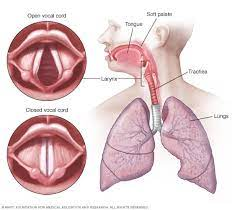Voice
Your natural voice
Keeping your natural voice is part of one’s overall health and wellness. A healthy voice allows for full participation in both school and extra-curricular activities. Students use their healthy voices to participate in class discussions, engage with peers on the playground, and interact with their teachers and families.
What is a healthy voice?
Voice is produced through a combination of airflow from the lungs and vibration at the vocal cords in your throat. In English, upon exhalation air travels from the lungs up through the vocal cords, causing them to vibrate. As the sound moves up the vocal tract you can make subtle changes to the palate, tongue, and/or lips to shape the sound into distinct phonemes (individual units of sound, such as /p/).

What is a Voice Disorder?
When a student is unable to use their voice to participate in school and extra-curricular activities it might be a sign of a voice disorder. Voice disorders can be temporary, due to a cold or virus, or chronic when there has been longer term strain/misuse of the vocal cords. Voice disorders occur frequently, due to many different reasons. When a voice disorder exists there could be changes in voice quality (e.g, hoarse, rough, breathy, weak, strained), changes to the pitch of the voice (e.g., higher or lower than usual or expected based on age), and/or changes to how the voice is used (e.g., “losing” the voice after regular amounts of talking, unable to sing, difficulty raising or lowering the voice volume).
What causes a voice disorder?
The causes for voice disorders are organized into three categories:
1. Vocal misuse (e.g., shouting);
2. Medically related (e.g., Gastro Esophageal Reflux Disorder (GERD), upper respiratory infections);
3. Congenital medical disorders with voice related problems (e.g., cerebral palsy, cleft palate).
Vocal Misuse is the most common category of voice disorders diagnosed in students. Each time we sneeze, clear our throat, cough, shout, or speak loudly the vocal cords come together with enough force to cause damage to the tissue if the behavior happens repeatedly over time, and more than would be natural as everyone engages in these behaviors from time to time. Other behaviors that can be damaging to the vocal cords are talking without good breath support, talking at a pitch that is either too high or too low, and/or whispering. Chronic misuse of the vocal cords by engaging in these behaviors can cause physical changes in the tissue over time resulting in vocal nodules or polyps and a hoarse or rough sounding vocal quality.
What can I do if I suspect a voice disorder?
Arrange to meet with the classroom teacher to share you observations and concerns. If appropriate, the classroom teacher will refer the student to the Speech-Language Pathologist (SLP) to screen their voice. If you have serious concerns always get in touch with your family physician immediately. And note, an SLP cannot begin treatment for a voice disorder without a medical examination usually provided by an Otolaryngologist (also known as an Ear, Nose, and Throat Doctor) as some intervention techniques are contraindicated depending on the diagnosis.
What does treatment look like?
If there is a medical reason for the voice disorder it may require medical or surgical intervention. However, most voice disorders fall into the vocal misuse category and are treated through biofeedback, lifestyle and diet modifications, exercises, and drills to achieve a healthy voice.

